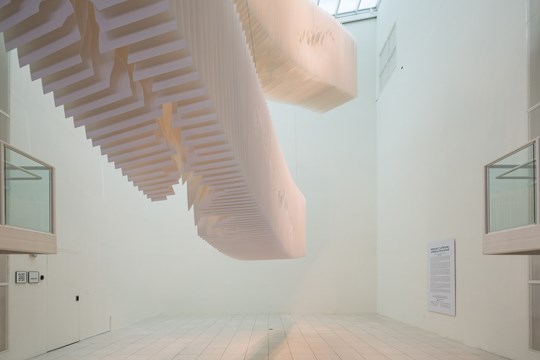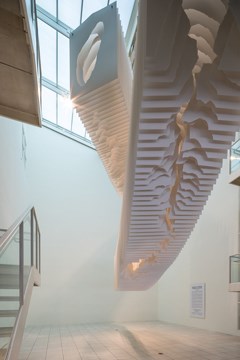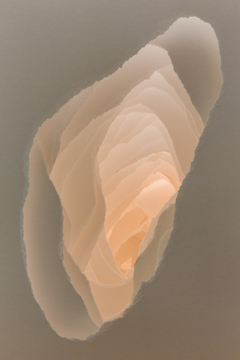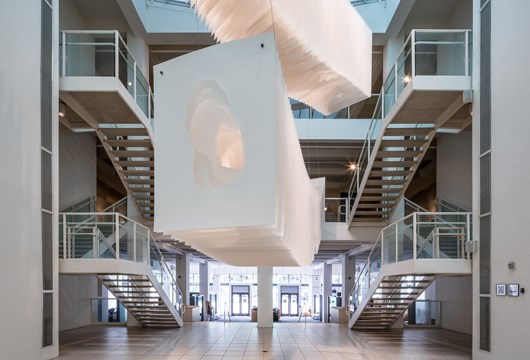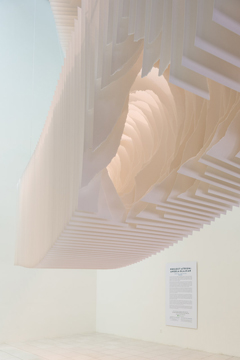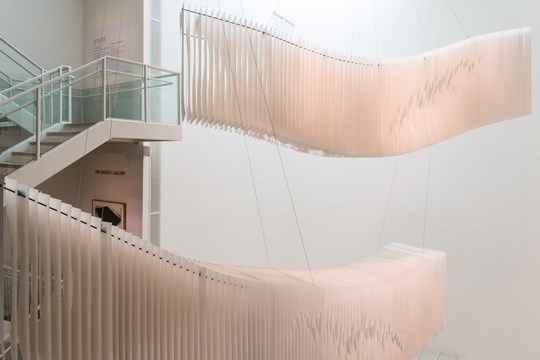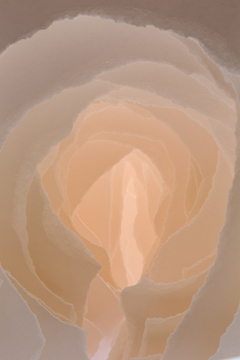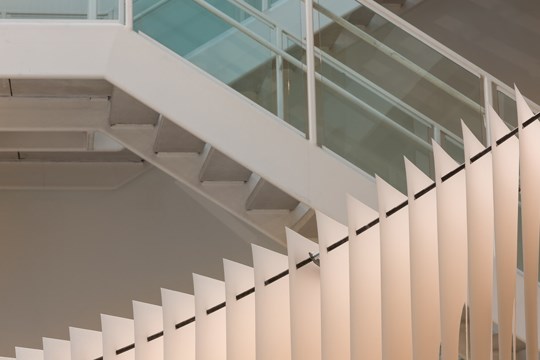PROJECT ATRIUM: ANGELA GLAJCAR
Terforation
MARCH 28, 2015 - JUNE 28, 2015
German artist Angela Glajcar redefines the capabilities of paper as a medium within the genre of sculpture. She is best known for her astounding installations of monumental, hand-torn sheets of pure white paper suspended in mid-air. In Terforation, the seemingly delicate and fragile hanging forms command a strong sculptural presence. Here, Glajcar sculpts not only the paper, but also the air, space, and light surrounding it.
Entering the gallery, the tactile sensibility of the paper seduces the viewer-the mysterious interior opening pulls the eye inward before directing the gaze to its exterior. The imprint of the artist's hand reveals itself in the torn rectangles-some with jagged edges, others with hollow centers. Each sculptural block, or serial motif, consists of approximately 150 sheets of paper hung at equally spaced intervals. Elongating in the space like a stretched accordion or unbound book, the repetition of sheets and forms expose how Glajcar, in essence, sculpts air.
The title of the piece and the larger series is a combination of the words, terra and perforation, that communicates the prescribed nature of the sculptor's practice. While the use of perforation references not only the act of tearing paper but also the visible apertures in the sculpture, the “terra incognita” or unknown land, as she refers to it, is now MOCA Jacksonville's gallery, where Glajcar installs her second-largest paper sculpture in the United States by stacking the oversized paper forms for the very first time.
MOCA Jacksonville's sculpture is part of larger series of two- and three-partTerforations, in which the evolution of the layer-from layering of sheets to layering of entire forms-separates the piece from its siblings. Glajcar, undeterred by the height of the Atrium, saw this project as an opportunity to further develop the theme of two-part sculptures. The rippling rhythm and motion of the upper block, though entirely still, reverberates in the sweeping form below, where light and shadow are now at play.
The oversized sculptures are often associated with the natural world-waves, tunnels, or even inchworms. The artist, however, chooses not to describe the abstract forms, leaving the interpretation entirely open to the viewer. Reading the inanimate objects can evoke personal memories or emotional reactions. After seeing a differentTerforation, an elderly woman once told the artist, “I can see my whole life in this. It's like a story.”
Project Atrium features site-specific and site-sensitive installations by emerging and mid-career artists. The unique placement, dimensions, and scale of the Atrium Gallery provide a compelling challenge to the chosen artist - a call to reinvention and active collaboration with the architecture of the Museum on a monumental scale.
ARTIST

ANGELA GLAJCAR
Born in 1970, in Mainz, Germany, Angela Glajcar now lives and works in Germany. She studied sculpture at the Akademie der Bildenden Künste in Nuremberg from 1991 to 1998. Glajcar has exhibited extensively and been the recipient of numerous awards and fellowships. In 1998, Glajcar received the Studio Award of the Kunststiftung Erich Hauser to draft paper collages for the steel sculpture Akrobat. In 1999, she was the recipient of the Asterstein scholarship, awarded by the government of Rhineland-Palatinate. At this point, Glajcar experiments with hanging paper works for the first time. In 2004, Glajcar received the Vordemberge-Gildewart-Award for which she produced Contrarius, a black and white site-specific installation at the Museum Wiesbaden. Shortly thereafter, Glajcar created the first Terforation in 2005. Today, the artist continues to push the capabilities of paper and also works with plastics and glass fabric. Her work is in several collections.
Image courtesy of Matthias Baus, Cologne.
SPONSORS
PRESENTING
![]()
![]()
SUPPORTING
Driver, McAfee, Hawthorne & Diebenow, >Boeing, Brooke and Hap Stein, Shaun Thurston

